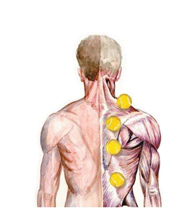Amid the spread of Covid-19 and a lockdown in place, many of us are faced with a “work from home” situation. As the home office becomes the new norm, it’s easy to fall into bad posture habits or end up with a workspace that makes you feel stuck in one position all day. Figuring out how to adapt to a new work environment can be daunting, especially when it involves fitting that space into your home.
Neck and shoulder pain is already common among office workers, but when you must create your own workspace and no longer have access to services, such as massage therapy. To aid in pain relief, it is up to you to invest in practices that will mitigate your pain and tension. To help make adapting a bit easier, I’ve compiled a list of tips to guarantee working from home won’t pain or stress your body:
- Stretching for your Posture
We all know that stretching takes a lot of effort and often we forget without meaning to. By targeting the muscles that generally contribute to posture related neck and upper back pain you’ll increase the efficiency of your daily stretching routine. These three stretches are for the upper body postural muscles that are often tight and short in individuals that spend a large portion of their day sitting.
- Door Frame Stretch to open up your chest wall and stretch your pectoral muscles.
- Levator Scapula Stretch to lower the shoulders away from the ears and lengthen the neck.
- Scalene Stretch to expand the space between your shoulders and ears, effective for people who find they lean or tilt their head.
- Creating an Ergonomic Work Space
Prevention is the key to avoiding persistent neck and back pain. You have total control over your work setup when it’s in your own home, that means you have the ability to create a space that encourages ideal sitting posture. Ideal sitting posture means computer screen at eye level, spine in a neutral position, elbows at 90°, wrist in a neutral position, thighs parallel to the floor and feet flat on the floor.
- Practicing Self-Massage
Sometimes it’s not possible to access a massage therapist and no matter how much we wish our friend or partner could get to that ONE spot, they just can’t seem to get to the spot you need. Self-massage, if done right, could be your knight in shining armor. Lacrosse balls are fabulous tools for deep tissue self-massage that can help relieve your pain and soften tight muscles. Unlike tennis balls, they do not squish with pressure allowing you to get more pressure in an area of tension. (If you do not own a lacrosse ball, don’t worry! Any ball of similar size and density will work)
- Frequent breaks
I often tell my clients posture isn’t about sitting in the perfect position, it’s about constant change. The human body is incredible at adapting to movements and positions, there’s no one position that is inherently harmful or “pain causing”. The worst thing that someone can do is remain in the same position for a long period of time. That’s when muscles become short and tight or long and weak, potentially resulting in pain. Taking frequent breaks will remind you and your body to keep moving!
- Stress Relief
Stress is a huge contributor to neck and upper back pain; the majority of my clients tell me they hold their stress and tension in their shoulders. Posturally, this can be observed as shoulders held up by the ears, shoulders rounded forwards and high muscle tone in the neck and back. A study done by the UK government found that stress, depression and anxiety accounted for 44% of all work related health issues. By engaging in self-care and managing stress levels, it is possible to minimize stress associated pain and tension. Mindfulness apps, such as Insight Timer and live online exercise classes such as Pilates are a great way to reduce stress levels. Alternatively, listen to music, be creative, enjoy nature; anything that you find enjoyable will work.
These are unpredictable times and a period of change for many of us, these tips are easy to implement and will make a huge difference in how your neck and upper back will feel. Try them out and let me know how they’ve worked for you! Ella Provan Bridge Health & Wellbeing
